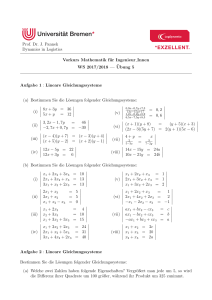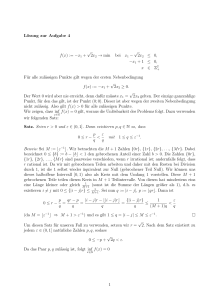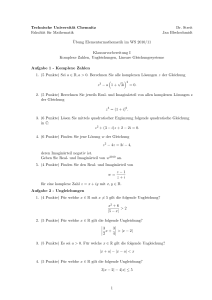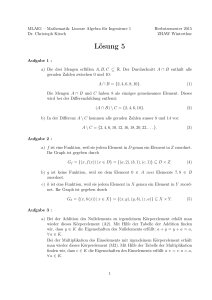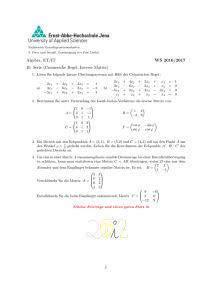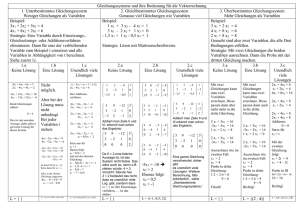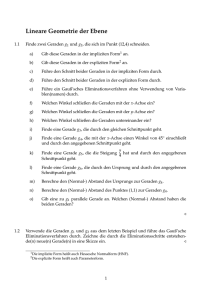Ubung 5 Aufgabe 1
Werbung
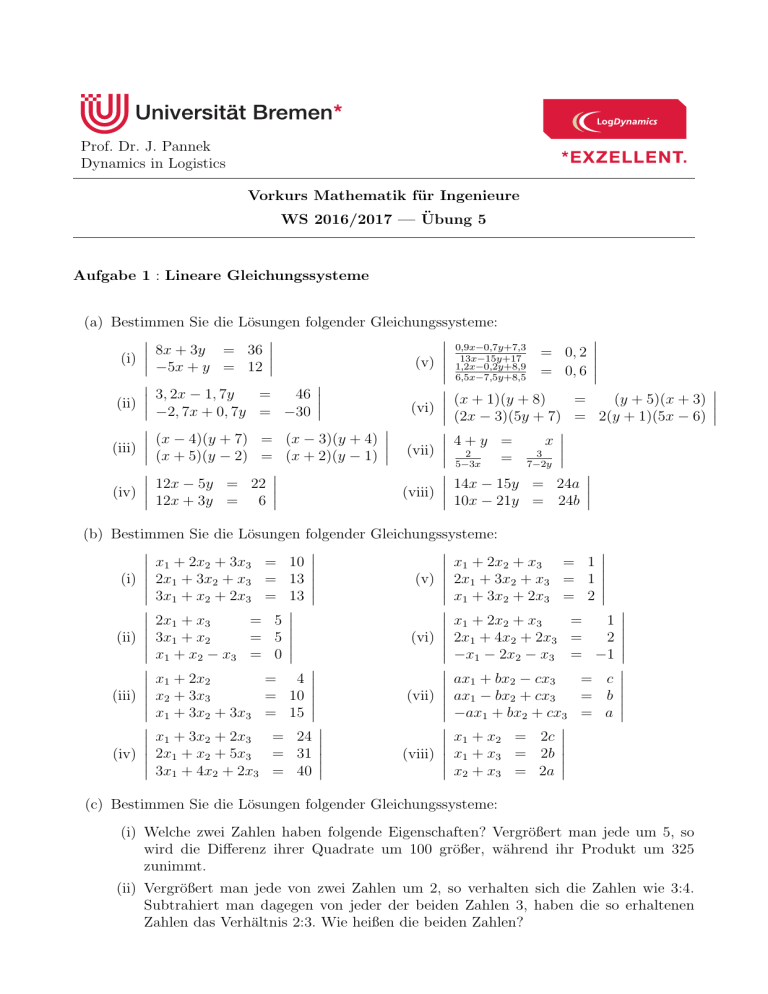
Prof. Dr. J. Pannek Dynamics in Logistics Vorkurs Mathematik für Ingenieure WS 2016/2017 — Übung 5 Aufgabe 1 : Lineare Gleichungssysteme (a) Bestimmen Sie die Lösungen folgender Gleichungssysteme: 0,9x−0,7y+7,3 = 0, 2 8x + 3y = 36 13x−15y+17 (i) (v) 1,2x−0,2y+8,9 −5x + y = 12 6,5x−7,5y+8,5 = 0, 6 3, 2x − 1, 7y = 46 (x + 1)(y + 8) = (y + 5)(x + 3) (ii) (vi) −2, 7x + 0, 7y = −30 (2x − 3)(5y + 7) = 2(y + 1)(5x − 6) (x − 4)(y + 7) = (x − 3)(y + 4) 4 + y = x (vii) (iii) 2 3 (x + 5)(y − 2) = (x + 2)(y − 1) = 7−2y 5−3x 14x − 15y = 24a 12x − 5y = 22 (viii) (iv) 10x − 21y = 24b 12x + 3y = 6 (b) Bestimmen Sie die Lösungen folgender Gleichungssysteme: x1 + 2x2 + x3 = 1 x1 + 2x2 + 3x3 = 10 (v) 2x1 + 3x2 + x3 = 1 (i) 2x1 + 3x2 + x3 = 13 x1 + 3x2 + 2x3 = 2 3x1 + x2 + 2x3 = 13 x1 + 2x2 + x3 2x1 + x3 = 1 = 5 2 = 5 (vi) 2x1 + 4x2 + 2x3 = (ii) 3x1 + x2 −x1 − 2x2 − x3 = −1 x1 + x2 − x3 = 0 ax1 + bx2 − cx3 x1 + 2x2 = c = 4 = b = 10 (vii) ax1 − bx2 + cx3 (iii) x2 + 3x3 −ax1 + bx2 + cx3 = a x1 + 3x2 + 3x3 = 15 x1 + x2 = 2c x1 + 3x2 + 2x3 = 24 (viii) x1 + x3 = 2b (iv) 2x1 + x2 + 5x3 = 31 x2 + x3 = 2a 3x1 + 4x2 + 2x3 = 40 (c) Bestimmen Sie die Lösungen folgender Gleichungssysteme: (i) Welche zwei Zahlen haben folgende Eigenschaften? Vergrößert man jede um 5, so wird die Differenz ihrer Quadrate um 100 größer, während ihr Produkt um 325 zunimmt. (ii) Vergrößert man jede von zwei Zahlen um 2, so verhalten sich die Zahlen wie 3:4. Subtrahiert man dagegen von jeder der beiden Zahlen 3, haben die so erhaltenen Zahlen das Verhältnis 2:3. Wie heißen die beiden Zahlen? Vorkurs Mathematik für Ingenieure WS 2016/2017 (iii) Die Summe zweier Zahlen beträgt 1000. Multipliziert man die erste Zahl mit 2, die zweite mit 3, so ist die Summe der Produkte 2222. Wie groß ist jede der beiden Zahlen? (iv) Die beiden Vororte X und Y einer Großstadt bilden mit deren Zentrum Z ein Dreieck. Von X über Z nach Y beträgt die Entfernung 12km, Y liegt 2km weiter vom Zentrum entfernt als X. Wie weit sind die beiden Vororte X und Y vom Stadtzentrum Z entfernt? Lösung: (a) Zwei lineare Gleichungen mit zwei Variablen (i) 8x + 3y = 36 ⇔ 23y = 276 x = 0 ⇔ y = 12 8x + 3y = 36 5 −5x + y = 12 | · 8 ← −+ (ii) 3, 2x − 1, 7y = 46 2,7 −2, 7x + 0, 7y = −30 | · 3, 2 ← −+ 3, 2x − 1, 7y = 46 ⇔ −2, 35y = 28, 2 x = 8 ⇔ y = −12 (iii) (x − 4)(y + 7) = (x − 3)(y + 4) (x + 5)(y − 2) = (x + 2)(y − 1) 3x − y = 16 ⇔ −+ −x + 3y = 8 | · 3 ← 3x − y = 16 ⇔ 8y = 40 y = 5 ⇔ x = 7 (iv) 12x − 5y = 22 12x + 3y = 6 | · −1 ← −+ 12x − 5y = 22 ⇔ −8y = 16 x = 1 ⇔ y = −2 (v) 0,9x−0,7y+7,3 = 0, 2 13x−15y+17 1,2x−0,2y+8,9 6,5x−7,5y+8,5 = 0, 6 ⇔ ⇔ ⇔ ⇔ 0, 9x − 0, 7y + 7, 3 1, 2x − 0, 2y + 8, 9 −1, 7x + 2, 3y = −2, 7x + 4, 3y = −1, 7x + 2, 3y = −1, 1y = x = 7, 3 y = 3, 7 = 0, 2(13x − 15y + 17) = 0, 6(6, 5x − 7, 5y + 8, 5) 2,7 −3, 9 −+ −3, 8 | · (−1, 7) ← −3, 9 −4, 07 Vorkurs Mathematik für Ingenieure WS 2016/2017 (vi) (x + 1)(y + 8) = (y + 5)(x + 3) (2x − 3)(5y + 7) = 2(y + 1)(5x − 6) ⇔ ⇔ ⇔ ⇔ xy + 8x + y + 8 = xy + 5x + 3y + 15 10xy + 14x − 15y − 21 = 10xy + 10x − 12y − 12 3x − 2y = 7 4 4x − 3y = 9 | · (−3) ← −+ 3x − 2y = 7 y = 1 x = 3 y = 1 (vii) 4 + y = 2 5−3x = x 3 7−2y ⇔ ⇔ ⇔ ⇔ −x + y = −4 2(7 − 2y) = 3(5 − 3x) −x + y = −4 9 9x − 4y = 1 ← −+ −x + y = −4 5y = −35 x = −3 y = −7 (viii) 14x − 15y = 24a 10 10x − 21y = 24b | · (−14) ← −+ 14x − 15y = 24a ⇔ 144y = 240a − 336b x = 7a − 5b 2 2 ⇔ y = 5a − 7b 3 3 (b) Drei lineare Gleichungen mit drei Variablen (i) x1 + 2x2 + 3x3 = 10 2 3 2x1 + 3x2 + x3 = 13 | · (−1) ← −+ 3x1 + x2 + 2x3 = 13 | · (−1) ←−−− + x1 + 2x2 + 3x3 ⇔ x2 + 5x3 5x2 + 7x3 x1 + 2x2 + 3x3 ⇔ x2 + 5x3 18x3 x1 = 3 ⇔ x2 = 2 x3 = 1 = 10 5 = 7 −+ = 17 | · (−1) ← = 10 = 7 = 18 Vorkurs Mathematik für Ingenieure WS 2016/2017 (ii) 2x1 + x3 3 = 5 3x1 + x2 = 5 | · (−2) ← −+ x1 + x2 − x3 = 0 | · (−2) ←−−− + 2x1 + x3 ⇔ −2x2 + 3x3 −2x2 + 3x3 2x1 + x3 ⇔ −2x2 + 3x3 0 x1 ⇔ x2 x3 beliebig = 5 = 5 = 5 | · (−1) ← −+ = 5 = 5 = 0 = − 21 x3 + 52 = 32 x3 − 52 (iii) x1 + 2x2 (−1) = 4 x2 + 3x3 = 10 x1 + 3x2 + 3x3 = 15 ← −+ x1 + 2x2 ⇔ x2 + 3x3 −x2 − x3 x1 + 2x2 ⇔ x2 + 3x3 0 = 4 = 10 = −11 ← −+ = 4 = 10 = −1 Das System hat keine Lösung. (iv) x1 + 3x2 + 2x3 = 24 (2) (3) 2x1 + x2 + 5x3 = 31 | · (−1) ← −+ 3x1 + 4x2 + 2x3 = 40 | · (−1) ←−−−− + x1 + 3x2 + 2x3 ⇔ 5x2 − x3 5x2 + 4x3 x1 + 3x2 + 2x3 ⇔ 5x2 − x3 5x3 x1 = 6 ⇔ x2 = 4 x3 = 3 = 24 (−1) = 17 −+ = 32 ← = 24 = 17 = 15 (v) x1 + 2x2 + x3 = 1 2 2x1 + 3x2 + x3 = 1 | · (−1) ← −+ x1 + 3x2 + 2x3 = 2 | · (−1) ←−−− + x1 + 2x2 + x3 ⇔ x2 + x3 −x2 − x3 x1 + 2x2 + x3 ⇔ x2 + x3 0 x1 = ⇔ x2 = x3 beliebig = 1 = 1 = −1 ← −+ = 1 = 1 = 0 x3 − 1 −x3 + 1 Vorkurs Mathematik für Ingenieure WS 2016/2017 (vi) x1 + 2x2 + x3 = 1 2 2x1 + 4x2 + 2x3 = 2 | · (−1) ← −+ −x1 − 2x2 − x3 = −1 ←−−−−−−−−−− + x1 + 2x2 + x3 ⇔ 0 0 x1 = ⇔ x2 beliebig x3 beliebig = 1 = 0 = 0 ← −+ −2x2 − x3 + 1 (vii) ax1 + bx2 − cx3 = c ax1 − bx2 + cx3 = b | · (−1) ← −+ −ax1 + bx2 + cx3 = a ←−−−−−−−−−− + ax1 + bx2 − cx3 ⇔ 2bx2 − 2cx3 2bx2 ax1 + bx2 − cx3 ⇔ 2bx2 − 2cx3 2cx3 x1 = b+c 2a ⇔ x2 = a+c 2b a+b x3 = = c (−1) = −b + c = a+c ← −+ = c = −b + c = a+b 2c (viii) x1 + x2 = 2c x1 + x3 = 2b | · (−1) ← −+ x2 + x3 = 2a x1 + x 2 = 2c (−1) ⇔ x2 − x3 = −2b + 2c x2 + x3 = ← −+ 2a x1 + x2 = 2c ⇔ x2 − x 3 = −2b + 2c 2x3 = 2a + 2b − 2c x1 = −a + b + c ⇔ x2 = a − b + c x3 = a + b − c (c) Sachaufgaben (i) Die beiden Zahlen seien x und y. (x + 5)2 − (y + 5)2 = x2 − y 2 + 100 (x + 5)(y + 5) = xy + 325 ⇔ ⇔ ⇔ ⇔ x2 + 10x + 25 − y 2 − 10y − 25 = x2 − y 2 + 100 xy + 5x + 5y + 25 = xy + 325 10x − 10y = 100 −1 5x + 5y = 300 | · 2 ← −+ 10x − 10y = 100 20y = 500 x = 35 y = 25 Vorkurs Mathematik für Ingenieure WS 2016/2017 (ii) Die beiden Zahlen seien x und y. x+2 = 3 y+2 4 x−3 ⇔ y−3 = 32 4(x + 2) = 3(x − 3) = 4x − 3y = ⇔ 3x − 2y = 4x − 3y = ⇔ −y = x = 13 ⇔ y = 18 (iii) Die beiden Zahlen seien x und y. x + y = 1000 (−2) 2x + 3y = 2222 ← −+ 3(y + 2) 2(y − 3) 3 −2 3 | · (−4) ← −+ −2 −18 x + y ⇔ y x = ⇔ y = = 1000 = 222 778 222 (iv) Die Entfernung von X zu Z sei x, die Entfernung von Y zu Z sei y. x + y = 12 x + y = 12 ⇔ y x − y = −2 | · (−1) ← = x + 2 −+ x + y = 12 ⇔ 2y = 14 x = 5 ⇔ y = 7
